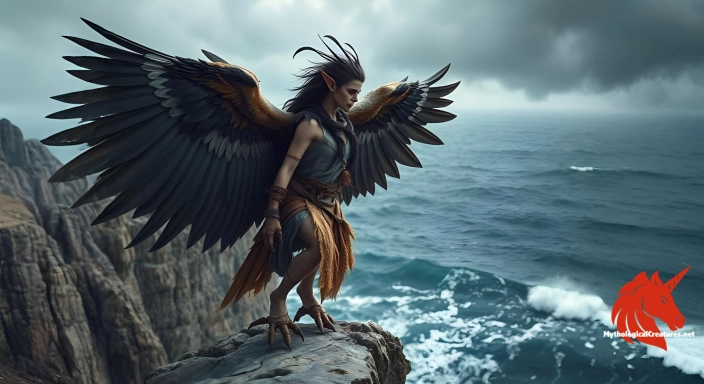Dhakhan: Dhakhan is an ancestral spirit from Gubbi Gubbi mythology, manifesting as a giant serpent with the tail of a giant fish.

Dhakhan
Dhakhan - Dhakhan is revered as the creator of snakes and serpents in the waterholes, exemplifying his role as a guardian of both the natural and spiritual realms.
Origins & First Encounters
Emerging from the rich oral traditions of the Gubbi Gubbi people, Dhakhan is revered as an ancestral spirit whose presence transcends the mundane. His form is a remarkable amalgam of a giant serpent and the tail of a colossal fish, a combination that symbolises the convergence of land and water. Often seen as a shimmering rainbow, he effortlessly traverses between the scattered watering holes that he calls home, embodying both beauty and mystery. His legendary status is embedded in the very fabric of Gubbi Gubbi culture, where he is celebrated as both a creator and a protector of life. Ancient narratives recount his pivotal role in shaping the environment, particularly in the nurturing of aquatic habitats. The enduring tales of his exploits have been passed down through countless generations, each retelling reinforcing the sanctity of nature and the environment. As a guardian of water and life, Dhakhan’s myth has always been interlaced with the cycles of rain and seasonal renewal. His luminous image, often associated with the spectrum of a rainbow, is a reminder of the wonder and power of the natural world. Through his timeless legacy, Dhakhan continues to inspire reverence for the interconnectedness of all living things.
Source Texts & Tale Variants
The primary accounts of Dhakhan are deeply rooted in the oral traditions of the Gubbi Gubbi people, with each story echoing the spiritual core of their relationship with the land. Elders and storytellers have preserved his myth through generations, offering variations that capture the essence of his role as both creator and guardian. In these narratives, Dhakhan is consistently portrayed as a powerful entity whose presence is felt during critical moments of environmental change. Some stories emphasise his emergence during times of drought, while others highlight his resourcefulness in replenishing the sacred waterholes. Colonial records, though fragmentary, hint at the awe with which his legend was once observed, even as they struggled to fully understand the depth of Indigenous spirituality. Variations in the stories have emerged due to the rich diversity within and between communities, each adding unique details to his character. The differing accounts share common themes of reverence for water, the transformative power of nature, and the cyclical balance of creation and destruction. Over time, these diverse narrative strands have woven a tapestry that underscores Dhakhan’s immense cultural significance. The oral tradition continues to be the primary source of knowledge, ensuring that his myth remains both vibrant and adaptable to changing times.
Form & Powers
Dhakhan is portrayed as an awe-inspiring figure whose physical form captivates the imagination of those who encounter his story. His body, sinuous and elongated, mirrors that of a giant serpent, while his tail distinctly takes on the form of an enormous fish, blending two elemental forces into one formidable creature. The creature’s skin is said to glisten with the iridescence of a rainbow, each scale catching and reflecting light in a dazzling display. Intricate patterns and natural designs adorn his form, reminiscent of water ripples and storm clouds that hint at his dominion over the aqueous world. His eyes, deep and enigmatic, are believed to hold the wisdom of the ages, silently conveying the mysteries of creation and nature. Artistic depictions often illustrate a fluid, almost ethereal quality to his movements, as if he were as much a manifestation of the weather as he is a physical entity. Some variations emphasise an overwhelming size that dwarfs the surrounding landscape, while others focus on the grace and fluidity of his dual aquatic and terrestrial form. The radiant spectrum seen on his body is not merely for show; it is symbolic of the life-affirming energy that emanates from him, especially in the sacred waterholes he frequents. In every detail, his physical appearance encapsulates the essence of transformation and the seamless blend of contrasting forces.
Regional Faces
The depictions of Dhakhan vary considerably across the regions inhabited by the Gubbi Gubbi and neighbouring Aboriginal communities. In some locales, his image is interwoven with the broader motif of the Rainbow Serpent, yet he retains distinctive features that set him apart as a unique ancestral figure. Certain traditions place a stronger emphasis on his role as a creator of aquatic life, while others highlight his governance over natural water sources and seasonal rains. Variants of the legend may include subtle differences in his bodily features or in the symbolic significance attached to his rainbow-like appearance. In regions where water scarcity is a recurring challenge, his myth often takes on an additional dimension as a bringer of life-sustaining rain. Local ceremonies and art have adapted his imagery to reflect the particular environmental narratives and ecological concerns of the area. Such regional adaptations underscore the dynamic interaction between myth and landscape, allowing Dhakhan’s character to evolve in response to local realities. The diversity in his portrayal speaks to a wider cultural dialogue where nature, spirituality, and community resilience are celebrated in varied forms. This regional mosaic of details not only enriches his character but also demonstrates the adaptability of myth to the local environment and cultural context.
Cultural Parallels
Across different mythological traditions, figures like Dhakhan occupy a unique space where the natural world and the spiritual realm converge. His dual nature as both serpent and aquatic creature invites comparisons with the wider tradition of Rainbow Serpents prevalent throughout Aboriginal lore, where the symbolism of water and creation is central. Similar themes can be found in other cultures that venerate serpentine creatures as both life givers and custodians of the natural order. For example, many Eastern mythologies celebrate water dragons and serpents that control rain and symbolise fertility, echoing the transformative powers ascribed to Dhakhan. The juxtaposition of his sinuous form with aquatic elements also parallels mythical creatures in European and African traditions, where serpents often embody both chaos and harmony. In many of these cultures, the serpent’s ability to navigate different realms illustrates a universal symbolic language of transformation and rebirth. The integration of vibrant, rainbow hues in his lore amplifies this connection, highlighting a cross-cultural appreciation for the beauty and mystery of natural phenomena. In drawing these parallels, Dhakhan’s character serves as a testament to how widespread and enduring the motif of the life-affirming serpent can be. His myth not only contributes to the unique tapestry of Indigenous Australian lore but also resonates with a global narrative of reverence for nature’s cyclical and regenerative power.
Legacy & Modern Evolution
Through the passage of time, the tale of Dhakhan has evolved from a deeply rooted oral tradition into a living symbol of cultural resilience and environmental stewardship. Modern reinterpretations have seen his image being revitalised in contemporary Indigenous art, literature, and performance, ensuring that his narrative remains both current and relevant. His storied past, once confined to the whispers of ancient gatherings, now finds expression in vibrant festivals and digital storytelling, bridging the gap between generations. This evolution has not diminished his original significance; rather, it has expanded his role as a mediator between ancient wisdom and modern ecological challenges. His visage, often represented as a radiant rainbow, has come to embody the hope and renewal that both traditional and modern communities aspire to. The reimagining of Dhakhan’s myth has also been instrumental in promoting environmental conservation, linking the sacredness of water to urgent contemporary issues. His enduring legacy continues to inspire collective efforts to protect the natural world, reflecting a broader commitment to preserving ancestral heritage. The dynamism of his story is a powerful reminder of how myth can adapt to changing times while retaining its core message. In celebrating Dhakhan, contemporary society not only honours a mythical figure but also rekindles the age-old bond between humanity and the natural environment. The modern interpretations of Dhakhan serve as both a tribute and a call to action, urging a harmonious coexistence with the Earth.
Interesting Fact
Dhakhan’s ability to manifest as a rainbow uniquely links the celestial and aquatic realms, highlighting a rare duality in mythological beings.
Quick Creature Info
Origin:
Features:
Associations:
Our Mythic Legendary Rating:

Habitat:
Supernatural Powers:
Physical Attributes:
Abilities:
Behavior:
Lore:
Related Creatures, Tales or Lore
- RRainbow Serpent (Indigenous Australian)
- YYurlunggur
- QQuetzalcoatl
References
Discover Another Mythical Legend You May Not Have Heard Of?
Uncover the mysteries of ancient folklore and expand your knowledge of legendary beings from cultures around the world.
Dare to Meet the Harpies....
Curated by the Mythological Creatures Team (rev. May 2025)
